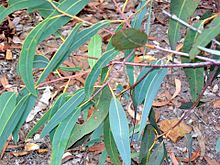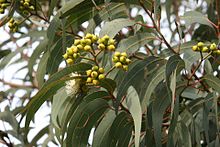Corymbia eximia
| Corymbia eximia | ||||||||||||
|---|---|---|---|---|---|---|---|---|---|---|---|---|

Corymbia eximia |
||||||||||||
| Systematics | ||||||||||||
|
||||||||||||
| Scientific name | ||||||||||||
| Corymbia eximia | ||||||||||||
| ( Shiver ) KDHill & LASJohnson |
Corymbia eximia is a species of the genus Corymbia withinthe myrtle family (Myrtaceae). It occurs only on the coast of New South Wales around Sydney and is called "Yellow Bloodwood" there.
description
Appearance and leaf
Corymbia eximia grows as a tree that reaches heights of up to 20 meters. The bark remains on the entire tree, is pale brown, yellow-brown or orange, checkerboard-like and fibrous pieces. The small twigs have a green bark. There are oil glands in the marrow, but not in the bark.
At Corymbia eximia is Heterophyllie ago. The leaves are always divided into a petiole and a leaf blade. The leaf blade on young specimens is ovate or elliptical to broadly lanceolate and has simple hairs and stiff glandular hairs. The leaf blade on medium-old plants is ovate or elliptical to broadly lanceolate, with entire margins and dull gray-green. The leaf stalk on adult specimens is 1.5 to 2.5 inches long and narrowly flattened or channel-shaped. The leaf blade of the same color on the upper and lower side on adult specimens is relatively thick, lanceolate to broadly lanceolate, sickle-shaped, with a length of 10 to 20 centimeters and a width of 1.3 to 3 centimeters, with a tapering base of the blade and a pointed upper end. The side nerves, which are barely recognizable, leave the median nerve at small intervals at an obtuse angle. On each half of the leaf there is a pronounced, continuous, so-called intramarginal nerve; it runs at a small distance along the edge of the leaf. The cotyledons ( cotyledons ) are almost circular.
Inflorescence and flower
At the end of a 10 to 30 mm long, in cross-section stalk-round or angular inflorescence stem stands a compound inflorescence , which consists of dold-like partial inflorescences each with about seven flowers. The peduncle is petal-round with a length of up to 2 mm in cross section.
The not blue-green floured or frosted flower bud is club-shaped to pear-shaped with a length of 10 to 15 mm and a diameter of 6 to 8 mm. The sepals form a calyptra that falls off early. The smooth calyptra is conical, slightly beak-shaped, as wide as the smooth flower cup (hypanthium) and shorter than this. The flowers are white or cream in color.
Fruit and seeds
The short-stalked fruit is 13 to 20 mm long and 10 to 15 mm in diameter, egg-shaped to slightly urn-shaped and three to four-fold. The disc is indented, the fruit compartments are included.
The regular and flattened, kneecap- or egg-shaped seed has a reticulate, dull to silk-matt, red or red-brown seed coat . The hilum is at the top of the seed.
Occurrence
The natural range of Corymbia eximia extends along the coast of New South Wales from Newcastle in the north to south of Wollongong . Corymbia eximia can also be found on the adjacent eastern roof of the Great Dividing Range .
Corymbia eximia thrives mainly and locally predominantly in sparse hardwood forests , on flat, sterile soils over sandstone , often on steep slopes.
Taxonomy
It was first published in 1843 by Johannes Konrad Schauer under the name ( Basionym ) Eucalyptus eximia Schauer in the Repertorium Botanices Systematicae , Volume 2 (5), p. 925. The type material has the inscription “ In Nova Hollandia olim. put. F. Bauer “on. The specific epithet eximia is derived from the Latin word eximius for extraordinary and refers to the appearance of the bark or the flowers. The new combination to Corymbia eximia (Schauer) KDHill & LASJohnson was made in 1995 by Kenneth D. Hill and Lawrence Alexander Sidney Johnson under the title Systematic studies in the eucalypts, 7. A revision of the bloodwoods, genus Corymbia (Myrtaceae) in Telopea , Volume 6 , Issue 2-3, p. 383. Another synonym for Corymbia eximia (Schauer) KDHill & LASJohnson is Eucalyptus eximia Schauer var. Eximia .
use
The heartwood is hard and slightly pink to yellow-brown. Its specific weight is 750–990 kg / m³. Due to the low height of the trees and their rarity, the wood is only processed to a small extent. The English common name Yellow Bloodwood is derived from the wood color, which can be traced back to the resin nerves.
Eucalyptus eximia is used as a street tree in Australian cities and, due to its low height, also as an ornamental plant for gardens.
Individual evidence
- ↑ a b Specimen search results: Corymbia eximia at Australia's Virtual Herbarium. Council of Heads of Australasian Herbaria . Retrieved February 19, 2013
- ↑ a b c d APNI = Australian Plant Name Index . Center for Plant Biodiversity Research. Australian Government. Retrieved February 19, 2013
- ↑ a b c d e f g h i j K. Hill: Corymbia eximia (Schauer) KDHill & LASJohnson at New South Wales Flora Online. National Herbarium of NSW, Royal Botanic Garden, Sydney. Retrieved February 19, 2013
- ↑ a b c d e f g h i j k l m Corymbia eximia at EucaLink - A Web Guide to the Eucalypts . Retrieved February 19, 2013
- ^ A b Douglas J. Boland, MIH Brooker, GM Chippendale & Maurice William McDonald: Forest Trees of Australia . CSIRO Publishing, Collingwood VIC 2006. ISBN 0-643-06969-0 . P. 254. ( Preview in Google Book Search, accessed February 19, 2013)
- ↑ Corymbia eximia at Tropicos.org. Missouri Botanical Garden, St. Louis, accessed February 19, 2013.
- ↑ Rafaël Govaerts (Ed.): Corymbia eximia. In: World Checklist of Selected Plant Families (WCSP) - The Board of Trustees of the Royal Botanic Gardens, Kew . Retrieved February 19, 2013.
- ^ Allan Fairey & Philip Moore: Native Plants of the Sydney District - An Identification Guide . Kangaroo Press, Kenthurst NSW 2000, ISBN 0-7318-1031-7 , pp. 196 . The source was available to the author of the article in the en: WP.
- ↑ Corymbia eximia - Yellow Bloodwood . Parks, Recreation & Leisure. City of Whitehorse, Victoria. Retrieved February 19, 2013
- ↑ Corymbia eximia - Yellow Bloodwood . City of Waverly, New South Wales. (PDF; 98 kB) Accessed February 19, 2013



